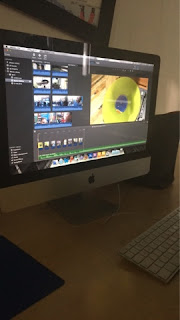This is our final and finished music video.
Lia Tamera - Under Control


 We also discovered it was very easy to edit the match cuts together and it looked very impressive, a key shot that stood out amongst our music video, it's something we want to film more of so that it can become more of a theme that runs throughout our music video; seen hopefully two or three times in total.
We also discovered it was very easy to edit the match cuts together and it looked very impressive, a key shot that stood out amongst our music video, it's something we want to film more of so that it can become more of a theme that runs throughout our music video; seen hopefully two or three times in total. Filming in Camden proved to be very straightforward we had no problems and I found the lip syncing very easy although at times I was a bit nervous to do it in public, I think it became easier as Milly was filming and therefore had a camera so it made what we were doing a bit more obvious. Choosing to film in quirky, off the cuff places such as graffiti walls and small niche places that featured nature or bright neon lights really helped convey the overall look we wish to achieve for our music video. The lights would have looked a lot more nicer and brighter if we shot at night, but we were conscious of loosing light and filming enough footage. A lot of the shots we filmed were filler shots, small shots that could be used as a transition piece in our music video; these featured both Charlotte and I. Whilst filming Milly also took pictures that could be used for our poster and digipak as we were keen to make sure that a similar theme runs throughout.
Filming in Camden proved to be very straightforward we had no problems and I found the lip syncing very easy although at times I was a bit nervous to do it in public, I think it became easier as Milly was filming and therefore had a camera so it made what we were doing a bit more obvious. Choosing to film in quirky, off the cuff places such as graffiti walls and small niche places that featured nature or bright neon lights really helped convey the overall look we wish to achieve for our music video. The lights would have looked a lot more nicer and brighter if we shot at night, but we were conscious of loosing light and filming enough footage. A lot of the shots we filmed were filler shots, small shots that could be used as a transition piece in our music video; these featured both Charlotte and I. Whilst filming Milly also took pictures that could be used for our poster and digipak as we were keen to make sure that a similar theme runs throughout. Camber Sands
Camber Sands Now having filmed, I feel that my Camden outfit fit the artist style mood board that we created earlier on.
Now having filmed, I feel that my Camden outfit fit the artist style mood board that we created earlier on. When we filmed in Camden Lock the second time, I went for a casual urban style which fit the location.
When we filmed in Camden Lock the second time, I went for a casual urban style which fit the location. This chosen outfit was worn during our Margate filming shoot. Adding a touch of femininity to all the previous looks we has decided upon, this stood out and soon became one of my favourite looks.
This chosen outfit was worn during our Margate filming shoot. Adding a touch of femininity to all the previous looks we has decided upon, this stood out and soon became one of my favourite looks.